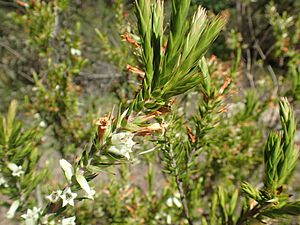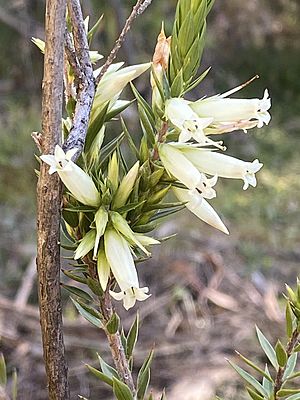Epacris calvertiana facts for kids
Quick facts for kids Epacris calvertiana |
|
|---|---|
 |
|
| Epacris calvertiana growing in the ANBG | |
| Scientific classification |
Epacris calvertiana is a special plant that belongs to the heath family, called Ericaceae. You can only find it growing naturally in New South Wales, Australia. It's a type of shrub that can stand up straight or spread out. Its leaves are shaped like an oval or an egg and have a sharp point. The flowers are usually white, pink, or red and grow along the ends of its branches.
What Does It Look Like?
Epacris calvertiana is a shrub that usually grows between 0.2–1.0 m (0.7–3 ft) tall. Its small branches are often covered in soft, woolly hairs.
The leaves are shaped like an oval or an egg. They are about 5.6–14.3 mm (0.2–0.6 in) long and about 1.3–3 mm (0.05–0.1 in) wide. Each leaf sits on a tiny stalk called a petiole, which is 0.9–1.4 mm (0.035–0.055 in) long. The tip of each leaf tapers to a sharp point.
The flowers grow along the leafy branches on small stalks called peduncles. These stalks are about 1–2.5 mm (0.039–0.098 in) long. Each flower is about 3–7 mm (0.12–0.28 in) across.
Each flower has five sepals, which are like small, leaf-like parts that protect the bud. These sepals are 6–10 mm (0.24–0.39 in) long. The petals are joined together to form a white tube, which is 10–16 mm (0.39–0.63 in) long. Sometimes, this tube can be pink or red. At the end of the tube, there are five lobes, or sections, that are 3.8–5.5 mm (0.15–0.22 in) long.
Inside the petal tube, you'll find the five stamens (the male parts of the flower that make pollen) and a single style (the female part that receives pollen).
How It Got Its Name
The plant Epacris calvertiana was first officially described in 1873 by a famous botanist named Ferdinand von Mueller. He published its description in a science journal called Fragmenta phytographiae Australiae.
The second part of its scientific name, calvertiana, was chosen to honor Louisa Atkinson. She was a talented Australian botanist and artist who collected the very first sample of this plant that scientists used to describe it. At the time, she was known by her married name, Louisa Calvert.
There are two main types, or varieties, of Epacris calvertiana:
- Epacris calvertiana var. calvertiana: This type usually has flowers that are 3–4 mm (0.12–0.16 in) across. Their flowers are typically white, cream-colored, or a creamy green.
- Epacris calvertiana var. versicolor: This type has larger flowers, usually 5–7 mm (0.20–0.28 in) across. Their flowers are pink to red, but the lobes at the end of the petal tube are white or cream-colored.
Where Does It Grow?
This plant, sometimes called "Drumstick heath," mostly grows along the coast and in the tablelands of New South Wales. You can find it from places like Pigeon House Mountain all the way to the Comboyne Plateau. It also grows inland as far as Berrima.
It likes to grow on cliffs and in rocky areas within forests, including rainforests. You can find it from sea level up to an altitude of 1,000 m (3,300 ft) (about 3,280 feet) high.


